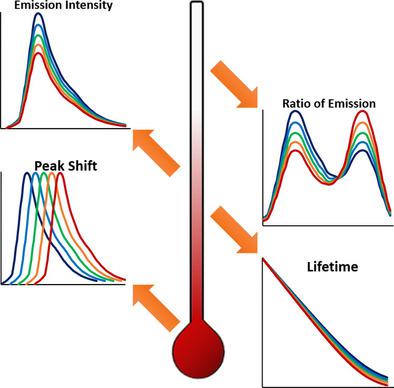当前位置:
X-MOL 学术
›
ChemPhotoChem
›
论文详情
Our official English website, www.x-mol.net, welcomes your
feedback! (Note: you will need to create a separate account there.)
Latest Trends in Temperature Sensing by Molecular Probes
ChemPhotoChem ( IF 3.0 ) Pub Date : 2020-01-28 , DOI: 10.1002/cptc.201900255 Meredith M. Ogle 1 , Ashleigh D. Smith McWilliams 1 , Bo Jiang 1 , Angel A. Martí 1, 2
ChemPhotoChem ( IF 3.0 ) Pub Date : 2020-01-28 , DOI: 10.1002/cptc.201900255 Meredith M. Ogle 1 , Ashleigh D. Smith McWilliams 1 , Bo Jiang 1 , Angel A. Martí 1, 2
Affiliation

|
In this Review, we summarize the work in the last ten years on the development of fluorescent molecular probes with possible applications in microscopic thermometry. We discuss four principal types of temperature‐dependent photoluminescence features: 1) Emission intensity; 2) Ratio of emission intensities; 3) Emission peak shift; and 4) Emission lifetime. We compare the advantages, limitations, and challenges of the different probes using these types of sensing mechanisms. By focusing on molecular probes, rather than nanoparticles or polymers, the mechanisms of temperature dependence are discussed thoroughly, with the most common including twisted intramolecular charge transfer (TICT), aggregation‐induced emission (AIE), and mechanically induced change in emission (MICE). With many different confounding variables associated with each experimental method and mechanism of temperature‐dependent photoluminescence, lanthanide and transition metal complexes seem to be promising candidates for future microscopic thermometry applications.
中文翻译:

分子探针进行温度传感的最新趋势
在这篇综述中,我们总结了近十年来荧光分子探针的开发工作,以及可能在显微测温中的应用。我们讨论了取决于温度的光致发光特征的四种主要类型:1)发射强度;2)发射强度比;3)排放峰移;4)排放寿命。我们比较了使用这些类型的传感机制的不同探针的优点,局限性和挑战。通过关注分子探针而不是纳米颗粒或聚合物,对温度依赖性的机理进行了详尽的讨论,最常见的包括扭曲的分子内电荷转移(TICT),聚集诱导发射(AIE)和机械诱导的发射变化(MICE) )。
更新日期:2020-01-28
中文翻译:

分子探针进行温度传感的最新趋势
在这篇综述中,我们总结了近十年来荧光分子探针的开发工作,以及可能在显微测温中的应用。我们讨论了取决于温度的光致发光特征的四种主要类型:1)发射强度;2)发射强度比;3)排放峰移;4)排放寿命。我们比较了使用这些类型的传感机制的不同探针的优点,局限性和挑战。通过关注分子探针而不是纳米颗粒或聚合物,对温度依赖性的机理进行了详尽的讨论,最常见的包括扭曲的分子内电荷转移(TICT),聚集诱导发射(AIE)和机械诱导的发射变化(MICE) )。











































 京公网安备 11010802027423号
京公网安备 11010802027423号